Excerpts from Jim Conrad's
Naturalist Newsletter
entry dated April 8, 2022, issued from near Tequisquiapan, elevation about 1,900m (6200 ft), ~N20.57°, ~ W99.89°, Querétaro state, MÉXICO
TOLOACHE, AMPHIBIOUS DATURA

The village's little reservoir, now in the late dry season having been dry for about a month, is an expanse of caked mud, glaring sunlight, and heat. Along the reservoir's edge where shallow water stands most of the year, with vegetation sometimes emerging, sometimes completely submerged, but now bone dry, Prickly-poppies, Argemone grandiflora are thick. And among the prickly-poppies suddenly the above has appeared.
Anyone paying attention to plants can recognize this as a datura, but who's seen a datura in such a habitat and with such a big flower on such a small body? And those leaves look peculiar for a datura or any kind. Here's a closer look at the 15cm long (half-foot) flower:
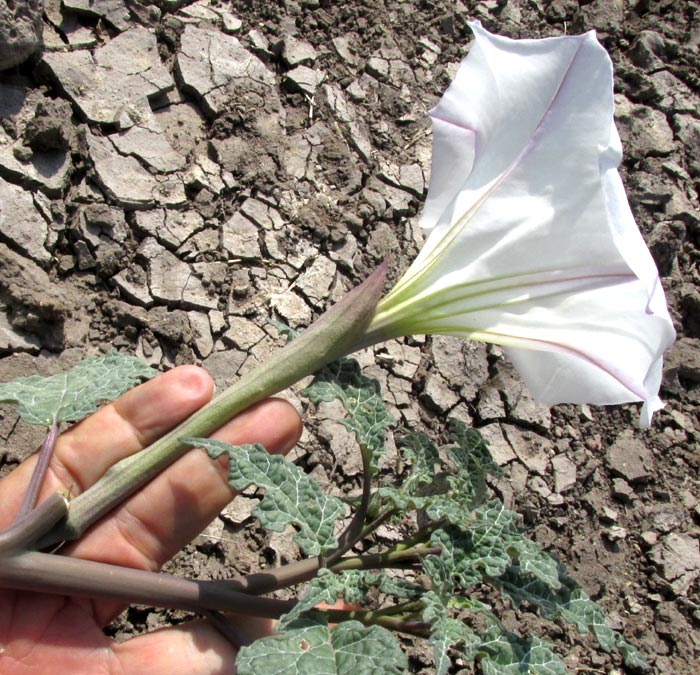
A peep into the corolla reveals no purple center such as some datura types have:
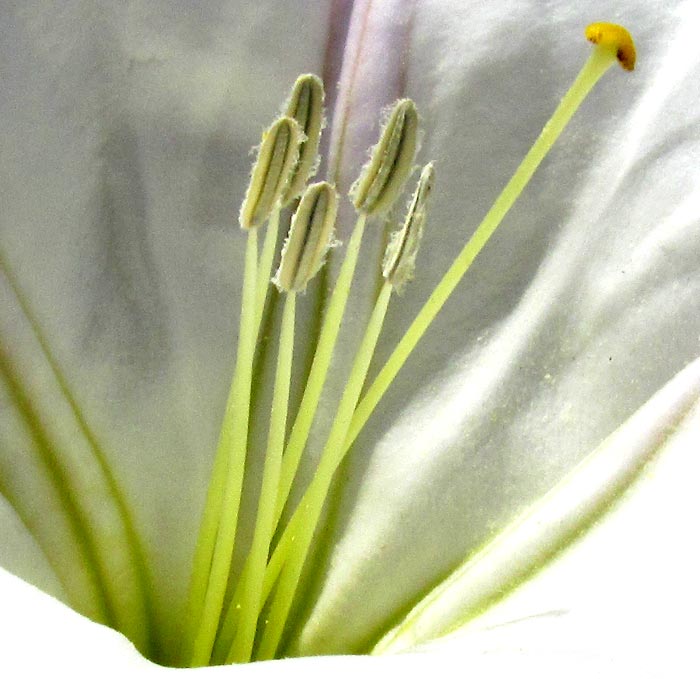
At the base of the plant it looks like the plant first formed a modest rosette, then bolted with a thick, succulent stem:

The online Flora del Bajío, the Bajío being that part of arid, upland central Mexico which includes Querétaro, has its Nightshade Family, its Solanaceae, finished, so we can see what datura species might occur here. It describes five datura species, of which only one fits our plant.
Here we have a datura species endemic just to the Mexican altiplano region, though it's reported to have recently expanded into New Mexico in the north, and Oaxaca in the south. It has no English name but among Spanish speakers is known as Toloache, though that name is used for several datura species. Our reservoir species is DATURA CERATOCAULA. It's an herb that can grow up to 1.5m high (5 ft) though if the rains return as they should in May, these plants may be drowned before reaching that height.
The species is described as short-lived annuals temporarily inhabiting inundated areas or even shallow water, so they are classified both as subaquatic and aquatic.
Daturas in general are famous for their toxic, hallucinogenic and medicinal qualities. Traditionally our Datura ceratocaula has been used medically for various pains, as a muscle relaxant and against asthma. It's also said to be hallucinogenic, and toxic.
entry dated May 3, 2022, issued from near Tequisquiapan, elevation about 1,900m (6200 ft), ~N20.57°, ~ W99.89°, Querétaro state, MÉXICO
TOLOACHE IN FULL BLOOM

During the driest part of the late dry season, many Toloaches blossom on the deeply cracked floor of the dry reservoir visited above.
entry dated July 31, 2022, issued from near Tequisquiapan, elevation about 1,900m (6200 ft), ~N20.57°, ~ W99.89°, Querétaro state, MÉXICO
TOLOACHE FRUITS & SEEDS

At the end of July this year the rainy season still hasn't arrived and the Toloaches on their hard-baked clay -- which normally at this time of year is submerged -- look a little weird, as seen above. Some plants are still flowering, and some bear immature fruits like those shown below:
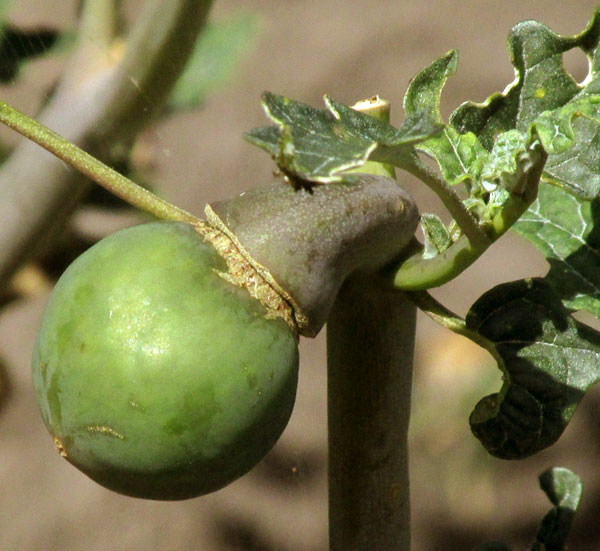
Among the thousands of plants at this location, not one bears a mature fruit, and I wonder whether someone has been picking them. However, on the hard clay below the plants, mature fruits like the one shown below, and those already brown and shriveled, can be found:
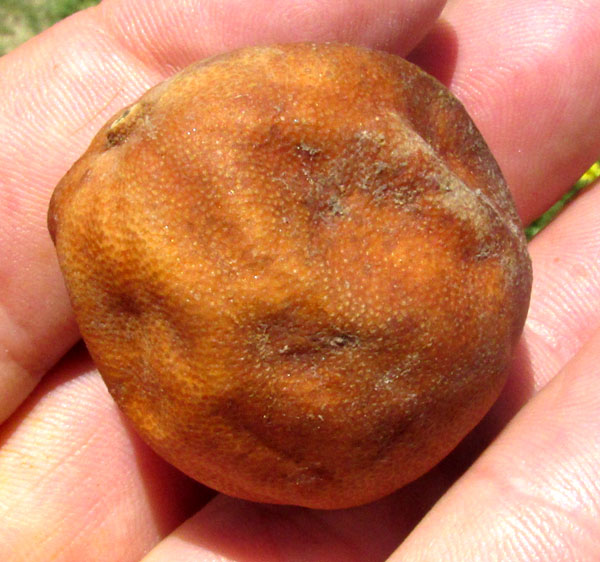
The capsular-type fruit's skin is very hard and leathery, and the contents are gummy, so opening them, at least these hard ones which have baked in the sun, is hard. The seeds, about 4mm long (5/32 inch), number only a few in each capsule -- 4 or 5 viable seeds in the photographed one. That's one shown below, still attached to its gummy, pleasant smelling, messy pulp:

Someone well may have been collecting mature fruits before they got hard and gummy. On the Web at this time I find ten Datura ceratocaula seeds being sold for US $6.50. Of course datura seeds of any kind are sought for drug use.
The wiki.medicinalplants-uses.com website's Datura ceratocaula page {previously said} that all parts of Datura plants contain dangerous levels of poison. They tell about a certain duck species in the lagoons near Mazatlán who eat the leaves and seeds of Datura ceratocaula. People who eat the duck have been known to develop symptoms of being poisoned or drugged, when the toxin moves up the food chain.
entry dated August 22, 2022, issued from near Tequisquiapan, elevation about 1,900m (6200 ft), ~N20.57°, ~ W99.89°, Querétaro state, MÉXICO
TOLOACHE IN WATER
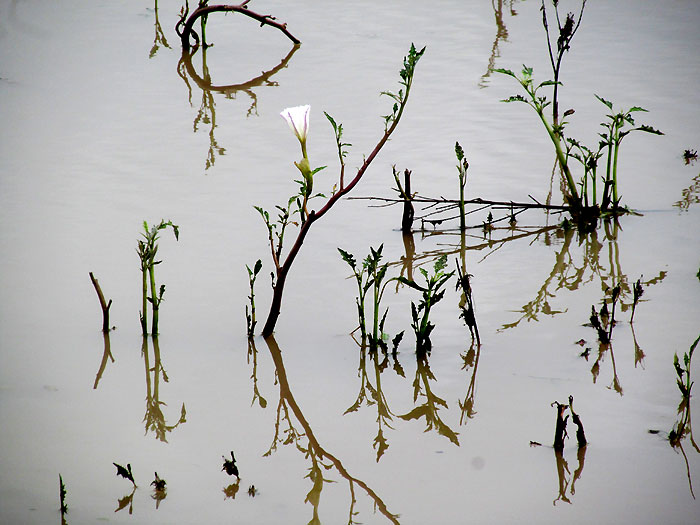
In August the rainy season comes two months late. The reservoir begins filling with water and here and there you see Toloaches as above, leafless and fruitless. If the rains continue as normal, the plant should be submerged before long.